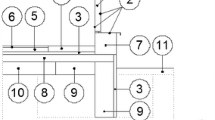Abstract
Selection of building materials in the design process is an important factor influencing not only future functionality of the building but also environmental performance. This paper deals with the environmental analysis of two material alternatives of one conventional Slovak masonry family-house with commonly used material composition in selected structures. Environmental analysis was aimed at the calculation of embodied energy, embodied CO2, and embodied SO2 emissions expressed as primary energy intensity (PEI), global warming potential (GWP), and acidification potential (AP), respectively. Total embodied energy of building materials (PEI) has been calculated to be equal to 780.1 and 698.4 GJ for A1 and A2 alternatives. Average calculated values of environmental parameters reached 2.19 MJ/kg of used materials for PEI; 0.105 kg CO2eq/kg for GWP and 0.71 × 10−3 kg SO2eq/kg for AP. Average values of building materials environmental parameters per floor area were calculated of 4,195.925 MJ/m2 for embodied energy (PEI), 202.5 kg CO2eq/m2 for embodied CO2 emissions (GWP) and 1.36 kg SO2eq/m2 for embodied SO2 emissions (AP). The results of the analysis point to the fact that it is possible to reduce the environmental impacts by up to 61.0 % in particular structures and by up to 10.5 % overall just by a simple change of several building materials in the structures.







Similar content being viewed by others
References
Asif M, Muneer T, Kelley R (2007) Life cycle assessment: a case study of a dwelling home in Scotland. Build Environ 42:1391–1394
Bamufleh HS, Ponce-Ortega JM, El-Halwagi MM (2013) Multi-objective optimization of process cogeneration systems with economic, environmental, and social tradeoffs. Clean Technol Environ Policy 15:185–197
Berge B (2009) The ecology of building materials. Elsevier, London
Čuček L, Varbanov PS, Klemeš JJ, Kravanja Z (2012) Potential of total site process integration for balancing and decreasing the key environmental footprints. Chem Eng Trans 29:61–66
Čuláková M, Vilčeková S, Krídlová Burdová E, Katunská J (2012) Reduction of carbon footprint of building structures. Chem Eng Trans 29:199–204
De Benedetto L, Klemeš J (2008) LCA as environmental assessment tool in waste to energy and contribution to occupational health and safety. Chem Eng Trans 13:343–350
Dixit MK, Fernandez-Solis JL, Lavy S, Culp CH (2010) Identification of parameters for embodied energy measurement: a literature review. Energy Buildings 42:1238–1247
Dodoo A, Gustavsson L, Sathre R (2011) Building energy-efficiency standards in a life cycle primary energy perspective. Energy Buildings 43:1589–1597
ECTP (2007) Strategic research agenda for the European Construction Sector. European Construction Technology Platform
EPBD (2010) Directive 2010/31/EU of the European Parliament and of the Council of 19 May 2010 on the energy performance of buildings (recast), Official Journal of the European Union, L153/13–L153/35
Gerilla GP, Teknomo K, Hokao K (2007) An environmental assessment of wood and steel reinforced concrete housing construction. Build Environ 42:2778–2784
Gustavsson L, Joelssona A (2010) Life cycle primary energy analysis of residential buildings. Energy Buildings 42:210–220
Gustavsson L, Pingoud K, Sathre R (2006) Carbon dioxide balance of wood substitution: comparing concrete- and wood-framed buildings. Mitig Adapt Strateg Glob Change 11:667–691
Khasreen MM, Banfill PFG, Menzies GF (2009) Life-Cycle assessment and the environmental impact of buildings. Rev Sustain 1:674–701
Loughlin DH, Yelverton WH, Dodder RL, Miller CA (2013) Methodology for examining potential technology breakthroughs for mitigating CO2 and application to centralized solar photovoltaics. Clean Technol Environ Policy 15:9–20
Milutienė E, Staniškis JK, Kručius A, Augulienė V, Ardickas D (2012) Increase in buildings sustainability by using renewable materials and energy. Clean Technol Environ Policy 14:1075–1084
Pieragostini C, Mussati MC, Aguirre P (2012) On process optimization considering LCA methodology. J Environ Manage 96:43–54
Porhinčák M, Eštoková A (2012) Process of selection of building materials towards sustainable development. Chem Eng Trans 29:547–552
Sartori AG (2007) Hestnes energy use in the life-cycle of conventional and low-energy buildings: a review article. Energy Buildings 39:249–257
Shukla A, Tiwari GN, Sodha MS (2009) Embodied energy analysis of adobe house. Renew Energy 34:755–761
Stajanca M, Porhincak M, Eštoková A, Kapalo P (2012) The environmental based selection of building materials in office building. Chem Eng Trans 29:559–564
Thormark CA (2002) Low energy building in a life cycle-its embodied energy, energy need for operation and recycling potential. Build Environ 37:429–435
Waltjen T, Pokorny W, Zelger T, Torghele K, Mötzl H, Bauer B, Boogmann P, Rohregger G, Unzeitig U (2008) Details for passive houses: a catalogue of ecologically rated constructions. Springer-Verlag, Vienna
Zabalza I (2013) Use of LCA as a tool for building ecodesign. A case study of a low energy building in Spain. Energies 6:3901–3921
Zhou L, Tokos H, Krajnc D, Yang Y (2012) Sustainability performance evaluation in industry by composite sustainability index. Clean Technol Environ Policy 14:789–803
Acknowledgments
This research has been carried out within the project of Scientific Grant Agency of the Ministry of Education, Science, Research and Sport of the Slovak Republic and the Slovak Academy of Sciences No. 1/0481/13 titled Study of building materials environmental impacts.
Author information
Authors and Affiliations
Corresponding author
Rights and permissions
About this article
Cite this article
Estokova, A., Porhincak, M. Environmental analysis of two building material alternatives in structures with the aim of sustainable construction. Clean Techn Environ Policy 17, 75–83 (2015). https://doi.org/10.1007/s10098-014-0758-z
Received:
Accepted:
Published:
Issue Date:
DOI: https://doi.org/10.1007/s10098-014-0758-z




